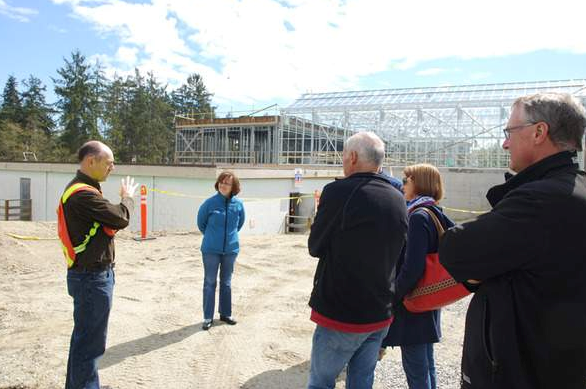Changes at the new sewer treatment plant site in Sechelt have used up nearly $400,000 of the District’s $500,000 contingency fund, project coordinator Paul Nash reported at the April 9 committee of the whole meeting.
He said changes “that have been accepted or are being contemplated” add up to $290,000 and that “other cost changes on our side of the fence for things like our consultant’s project management or other stuff add up to another $100,000.”
“We’re at just under $400,000 of our $500,000 contingency,” Nash said.
He explained that most of the changes were made (or were identified) in the first six months of the project and included things like habitat restoration, adding more doors to the design, realigning road accesses and other engineering fixes.
However, Nash said about 1/3 of the contingency funds were spent on “desirable changes,” like setting the new treatment plant up to deliver reused water for irrigation purposes.
“It was always a goal that we wanted to produce reuse quality water,” Nash said. “It was the responsibility of the proponent to produce reuse quality water, but actually how it gets sent places is not part of their responsibility.”
He said the recent switch from eight-inch water pipes in Sechelt to new 12-inch pipes presented an opportunity.
The old pipes, which are still functional, could be hooked up to the treatment plant and used to transport the water left over at the end of the treatment process, Nash said. That water would need to be chlorinated before it could be used, however.
“We can almost start doing so straight away if we repurpose some of our existing infrastructure. The service building at the old treatment plant will become the pump house and the chlorination station. That’s a perfect use for it because it’s already set up for pumping water. The pipe that runs out of it we will use as our reclaimed water delivery line and we have to put in a pipe from the new to the old plant and a separate new pipe from the new plant out to the delivery line,” Nash said.
“So we’ve worked hard with Maple Reinders consultants on how to make all of this happen in a very cost effective manner. It would be prohibitive to do this after the fact. One of the pipes in question would be buried under five metres of fill.”
He said the extra work would extend the project timeline by about two weeks, making the new “fully operational” date Dec. 15.
The only tricky part of the plan is the number of pipe connections that will be housed underground on site.
“We think that junction there at Ebbtide is possibly a world record for the number of pipes and junctions and valves within a 10 metre radius but that’s just the way it is. With some careful manipulation we’re able to reconnect everything and end up with a very useful result,” Nash said.
“We will then have a dedicated reuse water line going all the way up to upper Dusty and going all the way through the village out to the foreshore and we can tap into those at any point and take out chlorinated water for reuse.”
To date Maple Reinders has spent more than 30,000 hours working on the new treatment plant and Nash said there is now “mainly finishing work left to be done.”
The old public works building will come down in late July and landscaping on site will start in the fall, Nash said.
“Current date to start it up and actually turn the valve to bring in the first little bit of waste water is Oct. 20 and on that same day we can turn off the Ebbtide plant permanently. Dusty Road will still be in operation while we do the start up of the new plant and it’s projected that two weeks later we would turn off Dusty, however it remains on standby while we do the commissioning,” Nash said.
“Fully operational is when the new plant is effectively taking all the flow and then we go through a proofing period, which they have to satisfy before the project is deemed complete.”



